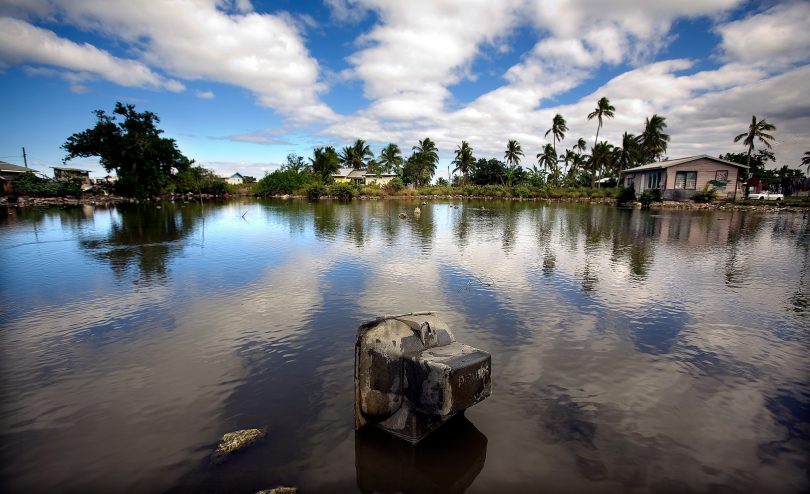The central instruments for implementing the Paris Agreement are the Nationally Determined Contributions (NDCs). These are climate action plans submitted by countries to the United Nations Framework Convention on Climate Change (UNFCCC) at COP 21.
All fourteen Pacific island countries submitted NDCs. They all include targets and implementation plans for achieving both mitigation and adaptation. The Pacific’s NDCs largely focus on reducing emissions in the energy sector, mostly by increasing renewable energy generation capacity and to a lesser extent actions on energy efficiency and green transport. The NDCs are therefore, both explicitly and implicitly, linked to the renewable energy targets that Pacific island countries have put forward.
While most Pacific island countries have included adaptation as a core priority in their NDCs, there are some marked differences. The NDC submitted by Kiribati devotes more text to adaptation than mitigation, and the Government of Nauru states in their NDC that the focus is ‘primarily adaptation, with a strong emphasis on building resilience which also encompasses mitigation in an integrated manner.’ Conversely, Palau only includes a short paragraph on adaptation in their NDC, and it is emphatically noted in the NDC submitted by the Federated States of Micronesia that they ‘do not see [the NDC] as the vehicle to address its adaptation needs in the post 2020 context’.
How can potential trade-offs between mitigation and adaptation be avoided or minimised? And, relatedly, how can climate action best result in broader development outcomes? In terms of mitigation it is possible to achieve broader development outcomes, build resilience, and cut emissions – for instance, through investing in renewable energy solutions that are also climate proofed and targeted to reduce energy poverty and increase rural productivity. There will be unavoidable trade-offs, however, between investing in adaptation and mitigation actions. This is because building adaptive capacity, which is linked to economic development and the stronger institutions and improved infrastructure it allows, will result in higher per capita emissions. It should also be noted that in the Pacific, due to low absolute and per capita emissions, the co-benefits of mitigation are a stronger driver of welfare improvements than the future impacts from cutting Pacific island countries greenhouse gas emissions. This point should be factored into the calculous of project design and implementation.
Achieving increased energy security is a high priority across the region due to the high reliance on imported fossil fuels and low levels of energy access, especially in Melanesian countries. Nevertheless, another important question is whether a rapid scale-up of renewable energy is the most cost-effective and economically efficient approach for decarbonising Pacific island countries. The NDCs in the Pacific have almost exclusively focused on the energy sector. This could be for the following reasons: (1) reducing emissions in the energy sector can easily be framed as an economic opportunity; (2) the emissions reductions in this sector are relatively easy to measure and monitor; and (3) most countries already have renewable energy targets. In the formulation of the next NDCs, which need to be communicated before 2020, Pacific island governments could strongly consider expanding the focus of NDCs to other sectors in addition to energy. For instance, the Pacific can also achieve mitigation through ecosystem-based adaptation approaches, such as blue-carbon projects which are highly effective strategies for mitigating climate change and provide high co-benefits, including coastal adaptation and biodiversity conservation.
The implementation of NDCs must also take place in the context of existing processes and institutions. The Pacific has a plethora of sectoral and national plans and policies and most countries (if not all) have existing climate change institutions, which include inter-ministerial working groups. NDC implementation, and the design of future NDCs, will be more effective if focused on innovative action. A Pacific government official interviewed as a part of a study by Oxfam on climate finance said that “NDCs will be another framework that could be useful if they’re converted into concrete plans and programs… But despite these plans, countries still accept what they’re given by donors and don’t negotiate to put their needs first because of concerns they’ll lose the funding.” While the concept of innovative climate action in the Pacific is open to debate, from my experience it includes: (1) a willingness for donors to invest at the community level; (2) delivering long-term projects that are country driven; and (3) reducing the administrative and reporting burden of governments accessing climate finance.
In addition to the Paris Agreement, countries have committed themselves to achieve the Sustainable Development Goals (SDGs) by 2030. NDC implementation that contributes to achieving the SDGs would result in wider sustainable development benefits, not just the reduction of emissions or achieving a narrow conception of adaptation. Instead of writing more plans and developing more national climate institutions, real progress will require investing in projects that result in tangible development benefits.



When you say “energy” you mean “electricity generation” – as none of the Pacific NDCs include targets or commitments for the energy used in the transport sector apart from Marshall Islands – despite the transport sector being single largest user of fossil fuels and arguably largest source of emissions. And all the donor funding to date has been targeted to electricity generation with only one exception (again project in RMI)